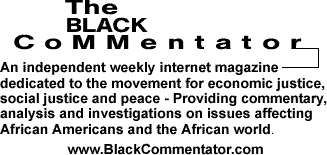
The 1958
Wichita Sit-in
African American Leadership
By Dr. Ron Walters, PhD
BlackCommentator.com Editorial Board
My friend George Curry reminded me of something in his article on �Being True to Black Historymakers� when he said that in this year when we celebrate the 50th anniversary of the Greensboro Sit-in that we must remember �they were not alone.�� It is true that these students were not alone, because in August of 1958, those of us in the NAACP Youth Council of Wichita, Kansas targeted the lunch counter at the Dockum Drug store in the heart of town for a Sit-in demonstration because they, like so many other establishments, did not let blacks eat there.� After about six weeks of Sit-ins that drew 20-40 young participants, we successfully desegregated, not just Dockum Drugs, but the Rexall chain of drug stores in that state.�
A few weeks later, the NAACP Youth Council in Oklahoma City began its own Sit-ins, headed by Barbara Posey (today, Dr. Barbara Jones, wife of Professor Mack Jones).� Through the entire year of 1959 they sat-in and eventually desegregated the Katz Drug store chain in that state.�� At the 1960s Convention of the NAACP they honored those of us who had begun this movement and two of the original Greensboro students attended the conference as members of the NAACP Youth Council.�� Moreover, Joseph McNeil, a key organizer of the Greensboro Sit-in said in an interview years later that they had heard of the Sit-ins in the Midwest in planning their own.�
In 2008, Kevin Myles, local head of the Wichita NAACP organized the 50th Anniversary celebration and the National Office of the NAACP recognized the Wichita Youth Council as a spearhead of the movement.� The Mayor of Wichita also christened a small park on the main street of town for Chester Lewis, a fighting attorney and head of the NAACP in the 1950s and 60s.� And today there is a replica of a lunch counter there, not five-hundred yards from the original Dockum Drug store.
Youth also made Black history this month, as a new Chair of the NAACP Board, Roslyn Brock, was announced in the press as taking over today.� The new team of 37 year-old CEO Ben Jealous and 44 year-old Roslyn Brock represents the passage of the baton to a new generation of leadership and they have already begun to use the tools of modern communication to organize new members and to extend the brand of the organization to new arenas of young professionals.�� Jealous, for example, set up a �war room� in Washington, DC to help mobilize the black community to participate in the action of contributing to a health care bill and countering the formidable power of paid lobbyists who are against it.
In one press report about Brock, it was striking to read a black professor suggesting that the NAACP was �searching for relevance.�� I began this discussion by not only making a bow to Black History month with a little known factoid, but by doing suggesting that youth today have a mandate from their history to engage in social struggle.��But today, the Tea Party radical conservatives are mobilizing while we are quiet.� Guess which group has created the perception that they represent a powerful national movement?
There should be no confusion about what constitutes the black agenda today, nor the tactics necessary to confront it.� The Tea Party folks represent a distorted White Agenda, seeking to utilize power to maintain the status quo.� As such, they would maintain the gaps in civil rights that still exist � citizen voting rights, felony voting rights, police brutality, racial profiling, housing discrimination, less access to loans.�� They would also maintain the gaps in human rights -- such as health insurance and the illnesses associated with the lack of care, educational access and excellence, employment rate equality, home ownership security and the like.�
It is the task of modern civil rights organizations to make the demand that equality be achieved, that fairness be the rule in the conduct of all American institutions.� It is their role to demand the closure of the gaps in civil and human rights, even though much of the technical and political work is carried out by our elected officials.� It is their job to mobilize black people and our allies, to influence institutions to behave in ways that honor our citizenship and humanity � in the 21st century.� This is not an old agenda, 50 years is actually a very short time.
The link below takes you to a YouTube documentary video of the 1958 NAACP Youth Council Sit-in in Wichita produced by television station KPTS in Wichita, Kansas.
http://www.youtube.com/watch?v=ehPVT9kKcHE
BlackCommentator.com Editorial
Board member, Dr. Ron Walters, is the Distinguished Leadership Scholar,
Director of the African American Leadership Center and Professor of Government
and Politics at the University of Maryland College Park. His latest book
is: The Price of Racial Reconciliation (The Politics of Race and Ethnicity) (University
of Michigan
Press). Click here to contact
Dr. Walters.
| Home |


